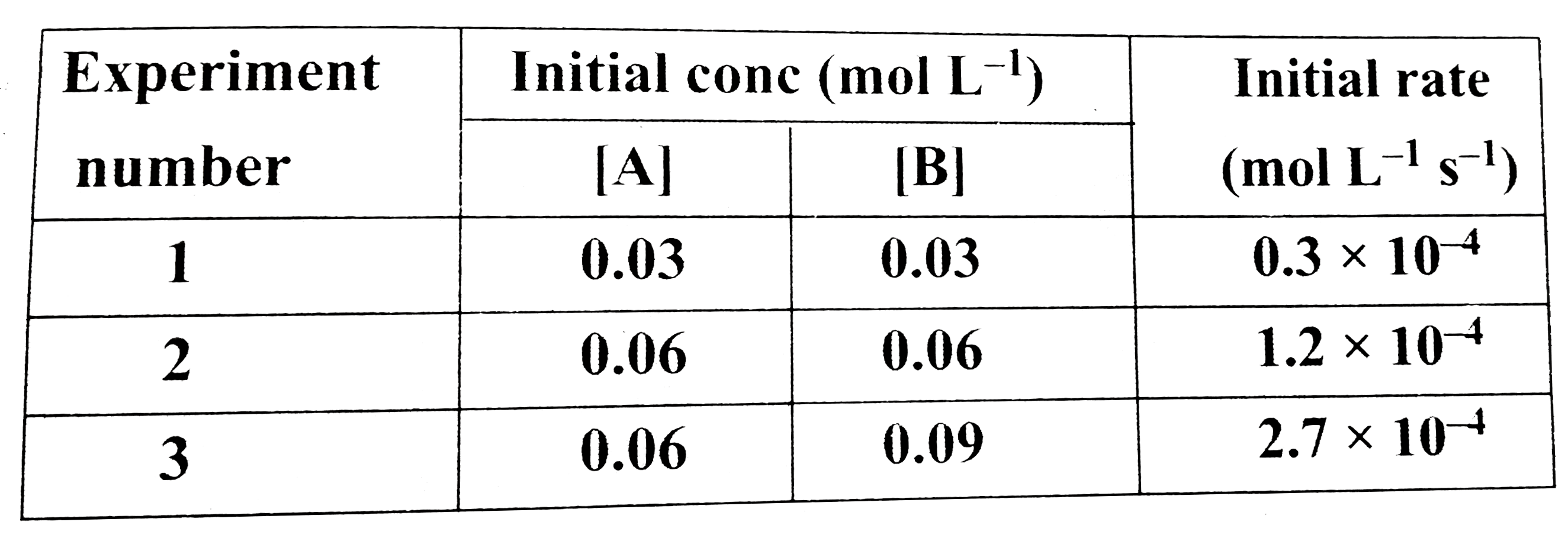Consider the reaction 2A+B→C+D
Following results was obtained in experiments designed to study the rate of reaction"

a) Write the rate law for the reaction
b) Calculate the value of rate constant for the reactio.
c) Which of the following possible reaction mechanisms is consistent with the rate law found in (a) ?
I. A+B→C+E (slow)
A+E→D (fast)
IIgt B→C+E (slow)
A+E→F (fast)
A+F→D (fast)
The rate law may be expressed as:
Rate = k[A]p[b]q…………….(i)
(Rate)1=k[0.1]p[0.10]q=1.5×10−3……………(i)
(Rate)2=k[0.20]p[0.20]q=3.0×10−3………..(ii)
(Rate)3=k[0.20]p[0.40]q=6.0×10−3...............(iii)
Divide equation (iii) by (ii)
k[2.0]p[0.20]qk[0.10]p[0.1]q=6.0×10−33.0×10−3=2
[2]q=[2]1 or q=1
Divide equation (ii) by (i)
k[0.20]p[0.20]qk[0.10]p[0.1]q=3.0×10−31.5×10−3=2
[2]p[2]q=2 or [2]p[2]1=2
or [2]b[2]6(1)=[2]1[2]0 or p=0
Order w.r.t. p=0, Order w.r.t to q=1
a) Rate law for the reaction =k[A]0[B]1
b) Value of rate constant from expt. No. 1.
k[0.10]0[0.10]1=1.5×10−3 or k=1.5×10−2
c) Since the order of reaction is one, reaction mechanism (II) is in consistent with the rate law. In this, the rate determining steps is:
B→C+E (slow)
Topper's Solved these Questions
- CHEMICAL KINETICSBOOK - DINESH PUBLICATIONCHAPTER - CHEMICAL KINETICSEXERCISE - Additional Numerical Problems For Practice
16 Videos
- CHEMICAL KINETICSBOOK - DINESH PUBLICATIONCHAPTER - CHEMICAL KINETICSEXERCISE - Brain storming Multiple choice questions.
10 Videos
- CHEMICAL BONDING AND MOLECULAR STRUCTUREBOOK - DINESH PUBLICATIONCHAPTER - CHEMICAL BONDING AND MOLECULAR STRUCTUREEXERCISE - Unit Test - 1
20 Videos
- CHEMICAL THERMODYNAMICS AND CHEMICAL ENERGETICS BOOK - DINESH PUBLICATIONCHAPTER - CHEMICAL THERMODYNAMICS AND CHEMICAL ENERGETICS EXERCISE - Exercise
507 Videos
Similar Questions
Knowledge Check
Rate law for the reaction, A+2B→C is found to be
Rate =k[A][B]
Concentration of reactant 'B' is doubled keeping the concentration of 'A' constant, the value of rate constant will be _______Athe sameBdoubledCquadrupledDhalvedFor a reaction ,A+B→C data is as follows :

the rate law for the reaction isARate =K[B]3BRate =[A]2[B]CRate =k[A]3DRate =[A][B]2The rate law for reaction A+2B⇔C+2D will be :
ARate = K[A][B]BRate =K[A][2B]CRate = K[A][B]2DRate =[C][D]2[A][B]2
The following results have been obtained during the kinetics studies of the reaction :
2A+B → C + D

Determine the rate law and the rate constant for the reaction.
View SolutionFor a reaction in which A and B form C, the following data were obtained form theee experiments:

What is the rate equation of the equation and what is the value of rate constant ?
View SolutionFor a reaction in which A and B form C, the following data were obtained form theee experiments:

What is the rate equation of the equation and what is the value of rate constant ?
View SolutionFor a reaction A+B→C+2D, experimental results were collected for three trials and the data obtained are given below:

The correct rate law of the reaction is
View SolutionFor the reaction , 2A+B→C+D, the rate law is rate =k[B].
Which of the following mechanism would be consistent with this information?
View Solution

